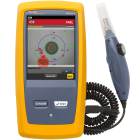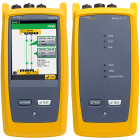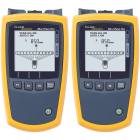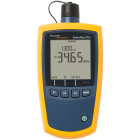A Guide to Fiber Optic Testers, Tools, and Troubleshooting
Fiber optic cabling is the high-performance core of today's datacom networks. As network speeds and bandwidth demands increase, fiber performance requirements have become more stringent. Fiber testing is more important than ever. What do fiber testers do? Which fiber tester is right for you? In this article, you’ll learn about the types of fiber optic testers and how they’re used. You’ll also learn about common fiber optic network problems, and how to test and troubleshoot cable networks to ensure optimal performance.
Contents
- What Is Fiber Optic Cable and Why Is It Used?
- What Is Fiber Optic Testing?
- Why Is Fiber Optic Testing Important?
- Methods of Fiber Testing and Tools Used
- How to Inspect and Test Fiber Optic Cable for Light Loss
- How to Test Fiber Connectors and Cables with Fluke Networks Tools
- Keep Learning
What Is Fiber Optic Cable and Why Is It Used?
Fiber optic cable is a type of cabling that contains one or more optical fibers for transmitting data at high speeds and/or over long distances using light. These fibers are most commonly made of glass and are very thin, typically less than a tenth of the width of a human hair. Fiber optic cable provides several advantages over traditional copper cabling, including faster data transfer rates, longer transmission distances, and immunity to electromagnetic interference.
What Is Fiber Optic Testing?
Fiber testing is the process of verifying the performance of optical fiber cabling. This process includes a range of tests and measurements such as insertion loss, optical return loss, and fiber length. It encompasses all of the standards, processes, and tools used to test the components of both newly installed and deployed fiber optic networks, including all components and functions.
Why is Fiber Optic Testing Important?
Fiber testing happens at various points during the life of a fiber cable network to help ensure proper performance before and after installation, as well as before and after changing, upgrading, or adding equipment.
Some of the most common causes of fiber optic malfunctions are excessive bending along the cable, faulty or damaged connectors, and contamination of end face connections. These issues can happen at any time; testing locates these problems and helps resolve them. Knowing the right tests to perform and having the right tools to use is key to keeping your fiber networks up and running.
Methods of Fiber Testing and Tools Used
Technicians use various tools to install, maintain, and troubleshoot fiber cabling: detection and verification testers, certification testers, inspection cameras, cleaning supplies, certification testers, and advanced optical time domain reflectometer (OTDR) instruments for troubleshooting and analysis of existing fiber optic cabling.
Fluke Networks is a market leader in enterprise fiber testing equipment, with a wide range of field-tough fiber testers to help you inspect, clean, verify, certify, and troubleshoot your fiber optic cable networks.
Here are some common types of fiber optic cabling testers and how they're used.
Fiber Detectors
These tools detect active signals in an optical fiber for testing ports, cables, and polarity. In many cases, knowing if fiber optic light is present or not can greatly simplify troubleshooting; since fiber optic light is invisible, a lot of time can be wasted in trial and error.
The FiberLert™ Live Fiber Detector removes the guesswork, detecting invisible fiber optic light to check fiber activity, polarity, and connectivity. No setup or interpretation is required — just place it in front of the fiber end face or port, and a light and tone indicate an active fiber.
See how FiberLert solves fiber problems quickly.
Visual Fault Locators
These tools inject visible light into a fiber which can be observed at the end face, bends, breaks or poor connections. They can test fibers in a cable before installation, determine if a terminated cable has been damaged, and trace fibers in a cable for identification and proper connection in the parts of the fiber that are easily inspected.
The VisiFault™ Visual Fault Locator locates fibers, finds faults including tight bends, breaks, and bad connectors, and easily verifies continuity and polarity to accelerate end-to-end fiber checks.
The VisiFault is an affordable tool for quick fiber location and elementary troubleshooting.
The Fiber QuickMap™ is a multimode fiber distance and fault locator that quickly locates severe bends, high-loss splices, breaks, and dirty connectors in multimode fiber without lengthy set up.
The Fiber QuickMap is an enterprise multimode fiber troubleshooter that quickly and efficiently locates contaminated connections and breaks in multimode fiber.
Light Sources and Power Meters
These tools measure insertion loss and power levels at the end of a fiber. Insertion loss the key factor in determining whether a fiber can support a given application. Power level is useful in establishing if a signal has sufficient strength to connect to the device at the other end.
For measuring the amount of light or the performance of a fiber optic link, the SimpliFiber® Pro light source and power meter solutions work together to measure multimode and single-mode fiber power and loss. This fiber optic cable troubleshooting tool has built-in results storage and automatic wavelength synchronization to save time and prevent errors.
The SimpliFiber Pro is an easy-to-use fiber-loss tester with advanced time-saving features. Choose from various configurations to meet your verification, inspection, and cleaning needs.
The MultiFiber™ Pro can certify MPO fiber trunks without the use of fan-out cords. This single-mode and multimode MPO fiber testing kit eliminates the complexity of polarity issues, and it makes cassettes easier to test in the field. It’s 90 percent faster than single fiber cable certification because it measures power loss and validates polarity on 12 fibers in a single connector — reducing test time from minutes to seconds.
MultiFiber Pro is a true MPO connector fiber tester that tests all 12 fibers at once, without the use of fan-out cords.
Certification of fiber optic cable links requires the right testing equipment, detailed knowledge of installation and application standards, and the ability to document your test results. The CertiFiber® Pro accelerates every step of the fiber certification process for multimode and single-mode networks. One button measures fiber length and optical loss on two fibers at two wavelengths, computes the optical loss budget, compares the results to the selected industry standard, and provides an instant PASS or FAIL indication. Save and analyze your test results with the included LinkWare™ Software.
The CertiFiber Pro Optical Loss Test Set has the fastest time to certify — two fibers at two wavelengths in under three seconds.
Fiber Inspection Scopes
Fiber inspection microscopes allow technicians to examine fiber end faces safely for contamination or damage, and to verify that cleaning procedures have been effective.
The FI-7000 FiberInspector™ Pro enables 1-second automated Pass/Fail certification of fiber optic end faces, eliminating human subjectivity from end face measurements. It provides graphical mapping of problem areas on the end face and allows you to save views during the certification process. It supports copper certification, fiber optic loss measurement, and OTDR testing, as well.
The FiberInspector Pro offers 1-second automated Pass/Fail certification of fiber optic connector end faces.
Optical Time Domain Reflectometer (OTDR)
Advanced ODTR tools are the ultimate tools for characterizing and troubleshooting a fiber optic link. Here’s how to use an OTDR to certify new links and detect problems.
How to Inspect and Test Fiber Optic Cable for Light Loss
Because fiber end faces are so small, contaminants that are too small to be seen can disrupt communications. In fact, contamination of connections is the leading cause of fiber network failures. While fiber optics inspection and cleaning fiber connectors is not new, it is growing in importance as links with increasingly higher data rates are driving ever-decreasing loss budgets. Contamination can also contribute to reflectance, which is critical to the performance of new short-reach single-mode applications. When clean connections are more important than ever, properly inspecting and cleaning fiber optic cables when they are installed or while making moves or changes becomes critical to the entire network.
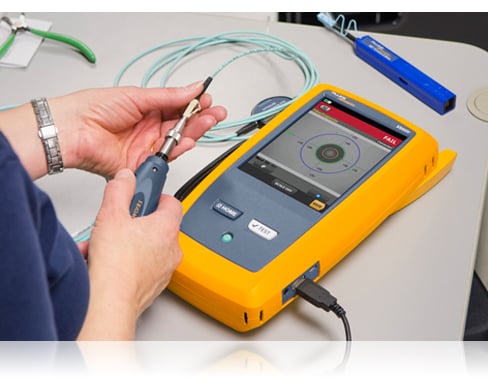
Inspecting fiber optic cable with the FiberInspector™ Pro
Two Common Fiber Optic Problems Revealed by Inspection
Inspection can uncover two types of problems that will cause loss or reflectance as light leaves one end face and enters another inside a connection: contamination and damage.
- • Dust, oils, and water-blocking gel are common forms of fiber connector end face contamination. Simply touching the ferrule will immediately deposit body oil on the end face, which will cause unacceptable attenuation once connections are made. Dust and small static-charged particles float through the air and can land on any exposed termination — especially in facilities undergoing construction or renovation. In new installations, buffer gel and pulling lube can easily find their way onto an end face.
- • Fiber optic cable damage appears as a scratch, pit, crack, or chip. These end face surface defects could be the result of poor termination or mated contamination. Deciding to mate every connection first and then inspecting only those that fail is a risky approach; the physical contact of mated connectors can transfer contamination from one end face to the other, or even cause permanent damage that would require more costly and time-consuming re-termination or replacement of pre-terminated links.
In the early days of fiber optic cabling, stereo bench-top microscopes were used to inspect fiber optic end faces. Over time, the development of smaller portable microscopes made testing fiber cable easier. Microscopes can be divided into two basic types: optical and video. Optical microscopes incorporate an objective lens and an eyepiece that allow the technician to view the end face directly through the device. Video microscopes incorporate both an optical probe and a display for viewing the probe’s image. The probes are designed to reach ports in hard-to-access places, and the screens allow images to be expanded for easier identification of contaminants and damage. Because the end face is viewed on a screen instead of directly, probes minimize the chance of a harmful laser light reaching the viewer’s eye. Newer testers, like the FI-7000 FiberInspector™ Pro, can store the end face image as part of a fiber test result and even provide a Pass/Fail indication based on industry standards.
If inspection finds no contaminants, cleaning is neither necessary nor advised. If contaminants are found, cleaning methods differ widely depending the nature of the contamination. Are you cleaning those end faces correctly? Take a look at some best practices for cleaning optical fiber.
How to Test Fiber Connections and Cables with Fluke Tools
The following videos demonstrate how to use Fluke tools to test fiber connections and cables.
How to Test a Fiber Transceiver
Fiber transceivers such as SFPs and QSFPs are a common source of failure in networks. Testing them typically involves interpreting power meter measurements, but many techs don’t have such a tool handy; many find it’s easier to guess at the problem and see if replacing the transceiver gets the link running again. The FiberLert Live Fiber Detector takes the guesswork out of the process so that you don’t waste time figuring out where the problem lies. (Fiber polarity can cause a lot of confusion — here’s a breakdown on fiber polarity basics.)
Is this transceiver working? Stop guessing. Know for sure with the FiberLert Live Fiber Detector.
How to Locate Connections and Breaks in Optical Fiber
For a simple, cost-effective way to locate fiber, connections, bends, and breaks, use the VisiFault™ Visual Fault Locator to quickly diagnose and repair simple fiber link problems.
VisiFault is an affordable tool for quick fiber location and elementary troubleshooting.
The Fiber QuickMap™ is a more advanced enterprise multimode fiber troubleshooter that quickly and efficiently locates connections and breaks in multimode fiber. This tool can instantly provide distances to failures such as high loss and high reflectance incidents. It’s capable of displaying up to 9 events and showing lengths in either feet or meters. In this video, there’s a broken fiber in a demo box. Watch how the Fiber QuickMap can locate the problem quickly and efficiently.
Here we have a broken fiber in a demo box, and we explain how the Fiber QuickMap can help you find the problem faster and more efficiently.
How to Inspect Optical Fiber for Contamination
The leading cause of fiber failures is end face contamination. Dirt, dust, and other contaminants cause insertion loss and reflection that stops fiber optic transmission and wreaks havoc with transceivers. An FI-500 FiberInspector™ Micro fiber optic inspection scope helps you ensure that your fiber cable is good to go.
The FI-500 is a breeze to use. The probe has key controls mounted on it for easy operation and is designed to fit into tight spaces.
How to Test optical Fiber and Measure Loss and Power Levels
Troubleshoot and verify optical fiber cabling systems with the right tools to measure loss and power levels, and to inspect and clean connect end faces. Whether you’re working on basic fiber verification capabilities or advanced troubleshooting and inspection, the SimpliFiber® Pro Optical Power Meter and Fiber Test Kits offer advanced yet easy-to-use capabilities that can reduce test time.
SimpliFiber Pro is an easy-to-use fiber-loss tester with advanced time-saving features. Choose from various configurations to meet your verification, inspection, and cleaning needs.

